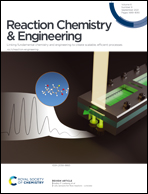Increasing saturation: development of broadly applicable photocatalytic Csp2–Csp3 cross-couplings of alkyl trifluoroborates and (hetero)aryl bromides for array synthesis†
Abstract
Visible light photocatalysis has emerged as an enabling technology capable of providing access to architecturally complex molecules. This article describes a systematic investigation of the nickel-mediated photocatalytic cross-coupling of alkyl trifluoroborates and (hetero)aryl bromides aided by high-throughput experimentation (HTE). The results obtained from HTE were utilized to select catalysts, bases and solvents for the production of chemical libraries. Six fourteen-member libraries were generated through couplings with secondary alkyl, primary α-alkoxymethyl, benzyl and secondary α-amino trifluoroborates, demonstrating that the optimized conditions were general, robust and exhibited broad functional group tolerance. The conditions were also successfully adapted for use in a flow reactor, showing the impact micro-scale screening can have in the development of scale-up procedures. These studies enabled the generation of a data-rich reaction guide that provides favorable conditions, as well as alternative conditions that can be used to address issues with substrate solubility or catalyst availability.



 Please wait while we load your content...
Please wait while we load your content...